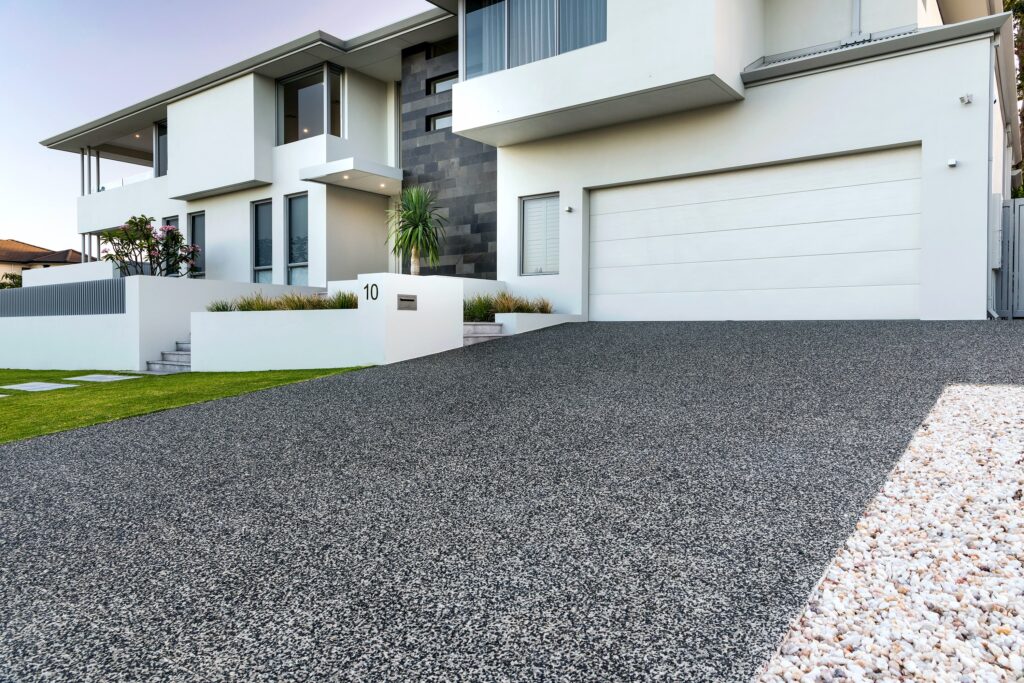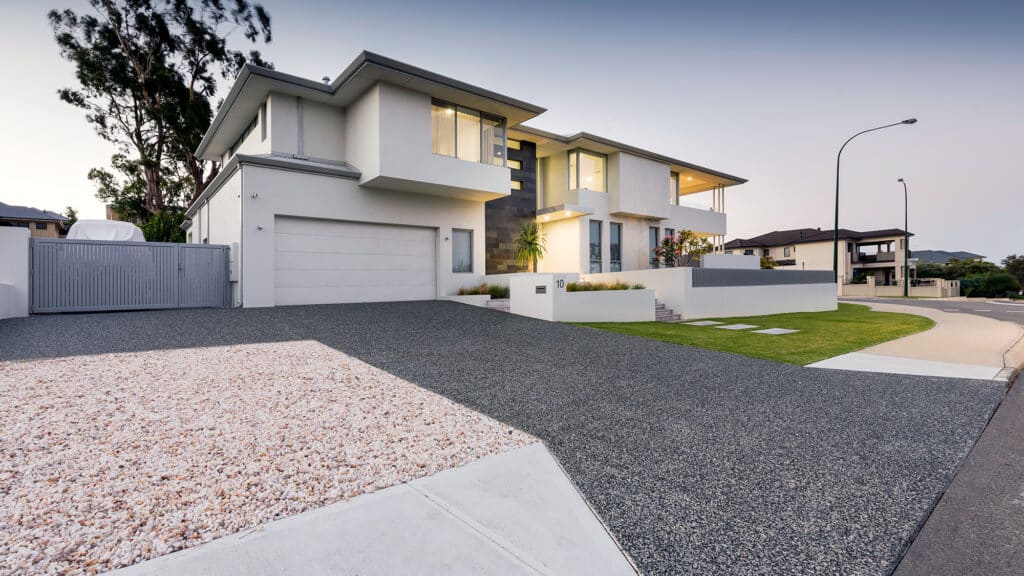Exposed aggregate is one of the most popular floor covering choices for Australian homeowners.
What is Exposed Aggregate?
Exposed aggregate is a washed concrete finish that features visible aggregates such as pebbles, rocks and sand. This type of finish could be applied to all concrete through the process of removing the surface layer, revealing the aggregates underneath. A benefit of exposed aggregate is its texture, which is considerably rougher than regular concrete, which makes it a popular choice for driveway and outdoor area installation. Exposed aggregate is one of the most popular decorative concrete finishes in Australia, particularly for outdoor applications.

How is Exposed Aggregate Done?
The process for finishing exposed aggregate concrete is accomplished by removing the top layer of cement, exposing the underlying aggregate. Exposed aggregate is an extremely durable material that boasts a raw and natural look. There are numerous types of aggregates that are used in decorative concrete finishes, coming in all different shapes and sizes. Popular aggregates utilised in decorative concrete include natural stones like granite, quartz and limestone. You can check out our available finishes in our swatch gallery.
Once the concrete has been poured onto the prepared surface, there are a few common methods for revealing the decorative aggregate. Depending on your desired finish and scope of your project, specialised equipment and chemicals may not be required. The aggregate exposing methods are:
- Washing & Brushing
- Chemical Surface Retarders
Types of Exposed Aggregate Finishes
With endless possibilities and combinations available, exposed aggregate is an extremely popular choice amongst homeowners in Australia. Beside changing the stone colours or types, there are differing finishing techniques that will impact the look of the concrete, based on your desired result.
Standard Exposed Aggregate
With a standard finish, the aggregate is mixed into the batch of concrete itself and therefore the decorative aggregate will be in a random placement when the surface layer is removed.
Maintaining Your Exposed Aggregate
Exposed aggregate surfaces are known to be extremely durable due to the strength of concrete that the aggregates are held in. Even in high foot traffic areas such as patios or alfresco areas, an exposed surface should last upwards of 40 years if cared for properly. Appropriate care for exposed surfaces includes applying sealer which aids in protection from oil spills, stains from standing water and other contaminants.
How often sealer needs to be reapplied depends on where the surface is located in the home and the level of wear it receives. Since it is a textured surface, keeping it clean will prolong its visual appearance.
How Much Does Exposed Aggregate Cost?
When compared to a regular, basic concrete surface, installing exposed aggregate is more expensive. This is mainly due to the additional labour required, needing additional products (such as chemical retarders) on occasions and the decorative aggregate added to the concrete mix.
The level of expense associated with exposed aggregate finishes can be impacted by the type of aggregate that is utilised. Some aggregates are far more expensive to use in an installation than others. To gain a better understanding of the potential costs associated, get in touch with our expert team!

Benefits of Exposed Aggregate Concrete
Installing an exposed aggregate finish affords a range of benefits to homeowners who choose to do so.
Durability
A key benefit of exposed aggregate is it’s a tough, durable material that can take more pressure than real stone can. Exposed aggregate can also withstand years of harsh weather, with minimal maintenance required. If cleaned and sealed, your exposed aggregate surface will maintain is visual appeal for years, regardless of where it is poured around the home.
Low Maintenance
Another advantage of exposed aggregate surfaces is that they do not require comprehensive upkeep to maintain them. Applying polish is not required for exposed surfaces, but approximately every five years, it should be sealed which aids in maintaining the surface’s visual appeal. Simply cleaning off the surface with a hose or high-pressure water cleaner is as much maintenance that is required. Due to its hard-wearing properties, contractors regard it as one of the most practical choices for homeowners.
Highly Customisable
The variety of aggregate concretes that are available is another reason for its popularity amongst homeowners. By combining different stones and colours, you can create a completely bespoke design for your home. Different coloured aggregate can be used to produce different patterns or to resemble alternative materials.
Potential Limitations of Exposed Aggregate Concrete
While the benefits of exposed aggregate concrete finishes are extensive, the following are some of the potential limitations associated.
Hard To Install Yourself
The installation process for exposed aggregate is a challenging one that takes great care and craftmanship. Overexposing the aggregate can prove disastrous as it impacts the integrity of the pour. It is recommended that exposed aggregate is not attempted as a DIY project unless you have extensive concreting experience.
Can Be Prone To Damage
At times, decorative stones can be prone to breaking. If exposed to consistent, heavy traffic, there is a possibility they can become damaged. This highlights the importance of using only professional quality aggregates, which are less susceptible to damage from foot and vehicle traffic.
Repair Work is Difficult
Completing patch work or repairs on exposed aggregate is a complicated process. The largest challenge comes from blending the patched surface into the rest of the concrete application. It is recommended that any patch work concrete is tinted to replicate the original surface before filling any gaps. Instead of feathering the new concrete over the surrounding area to level it out, it is recommended to pour just enough to fill the hole and then pack the stones into the new concrete. Time should be taken to find aggregate that matches the existing surface as closely as possible – should you have trouble with this, the team at Terrastone are always here to help!